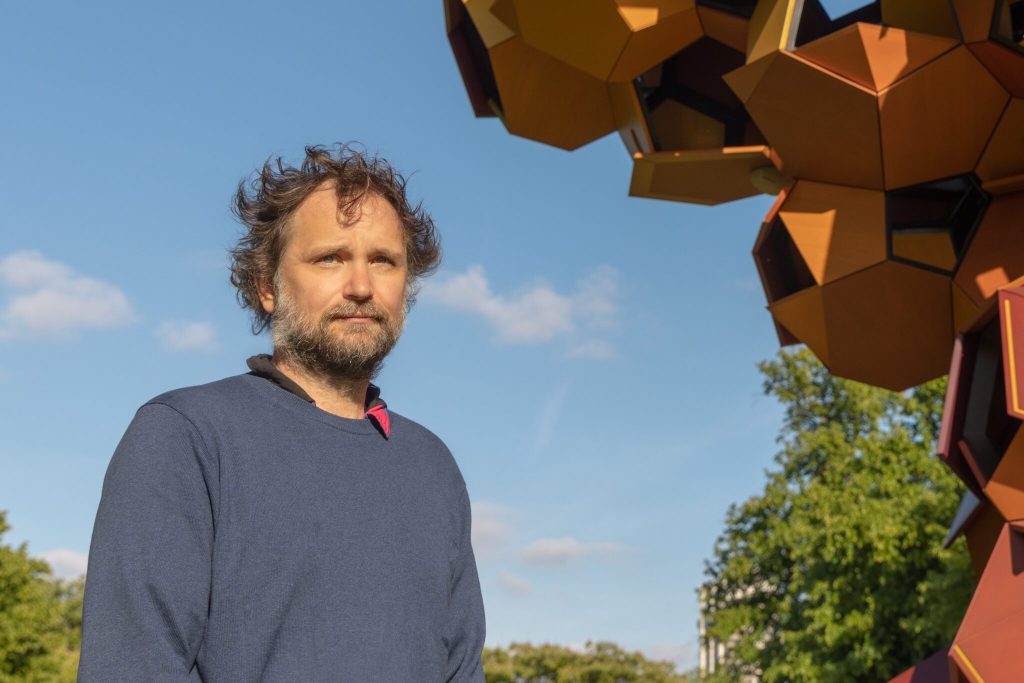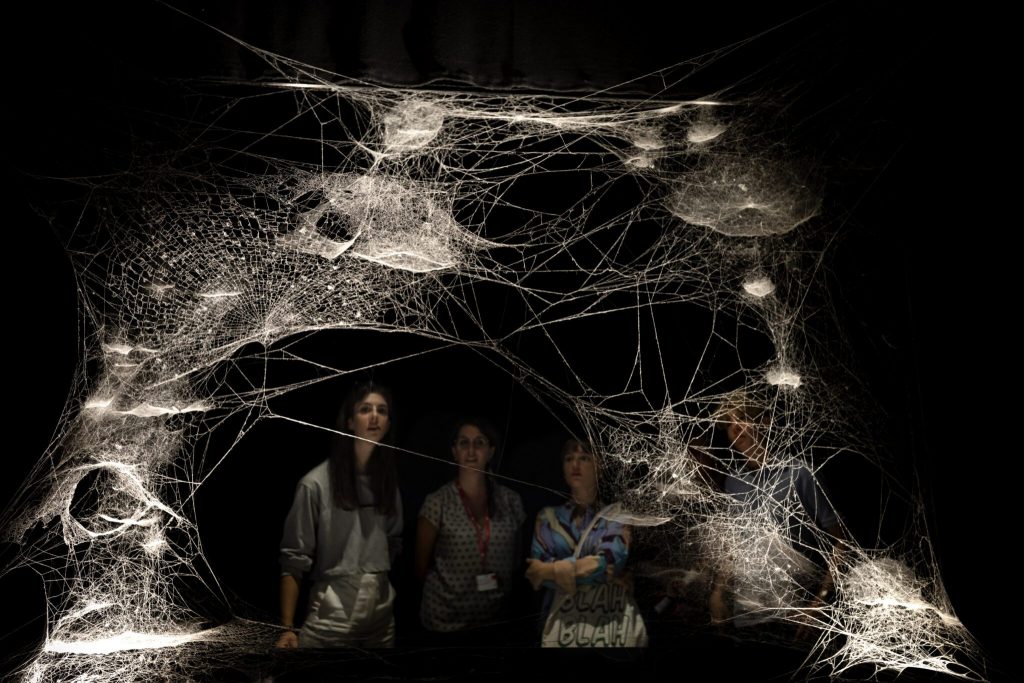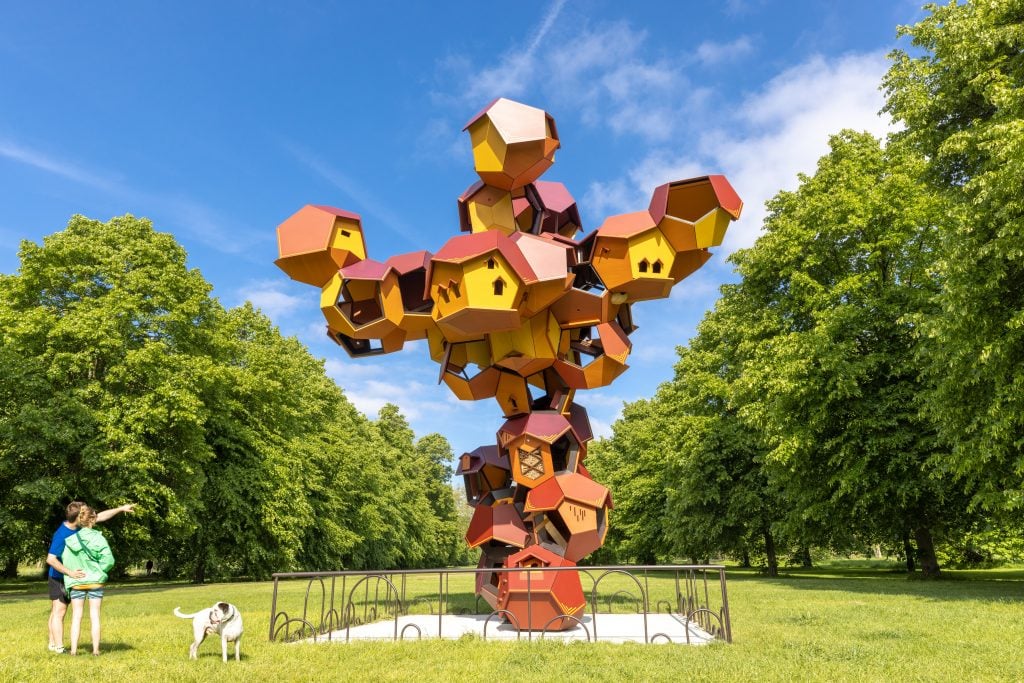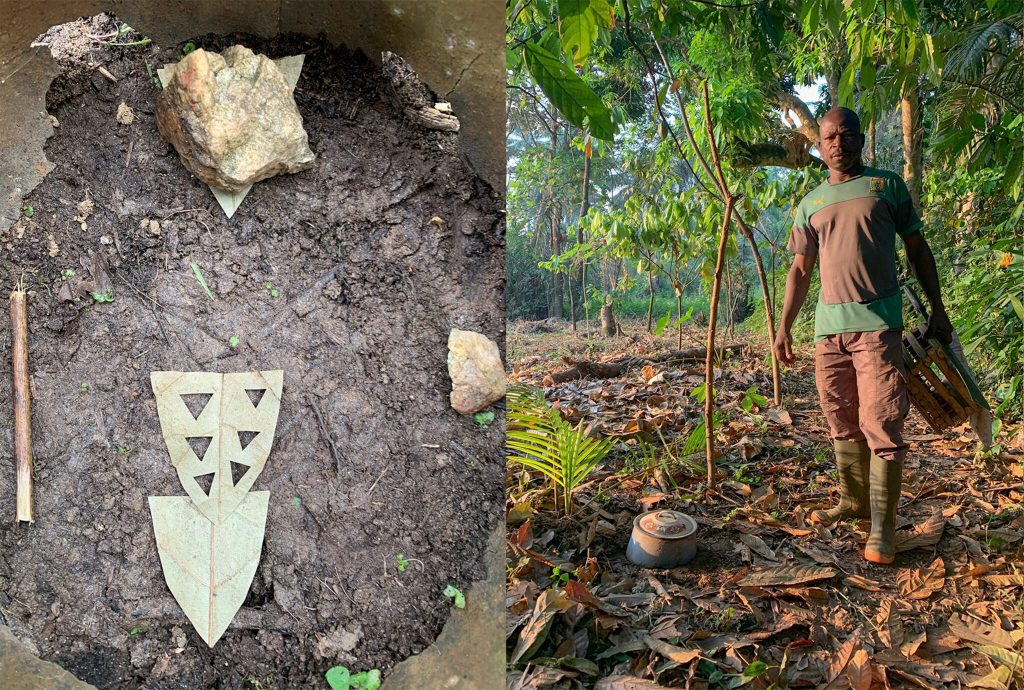People
Artist Tomás Saraceno on How He Made the World of Spiders Audible to the Human Ear
The solo exhibition "Web(s) of Life" is on view at the Serpentine Galleries in London until September 10, 2023.

The solo exhibition "Web(s) of Life" is on view at the Serpentine Galleries in London until September 10, 2023.

Kate Brown

Just because we cannot hear a spider, does not mean its world is not full of sound. That is one of the remarkable truths that artist Tomás Saraceno wants to make evident: In a recent technological feat, he captured and recorded the sounds of a spider building its web—just one of the many experiments that breaks beyond the traditional bounds of the art world. It’s an ambitious undertaking, and it has solidified him as one of the more impactful artists of his generation.
For his first major U.K. solo exhibition at the Serpentine Galleries in London, Saraceno and his collaborators moved beyond the walls of the museum as well. In “Web(s) of Life,” the artist considered the delicate ecosystem of which the museum is a part in novels ways—from the Royal Parks just beyond the institution, all the way to rural communities of Argentina, where people are fighting to stop lithium extraction in their lands. Much of Saraceno’s work renders visible our interconnectedness with one another and the world and ecosystems in which we exist, and delves into critical and urgent questions about how we coexist with other forms of life, and how technology intersects with the climate.
Earlier this summer, Saraceno joined us on the Art Angle to speak about his unique approach to art, the power of meditation, the risks of artificial intelligence, and what we can learn from listening and seeing in new ways.
Read an edited excerpt of this first few minutes of the interview below. To hear the full audio version, tune into the episode on the Art Angle podcast.

Installation view of “Spider/Web Pavilion 7: Oracle Readings, Weaving Arachnomancy, Synanthropic Futures: At-ten(t)sion to invertebrate rights!” (2019), at the 58th Biennale di Venezia, curated by Ralph Rugoff. Photo: Studio Tomás Saraceno, courtesy of the artist.
We are sitting together in your studio, which is a multi-story former factory on the outskirts of Berlin. Just next door to us are spiders, which I was quite surprised to see simply existing in the space. They’re not boxed into glass. Their webs are standing actually on Club Mate crates rather casually. Can you explain the ecosystem that’s happening here?
When you start noticing something, then you notice it everywhere. After people go to my exhibitions, they call me and say, “Oh, I found a spider web in my home.” This idea plays with this human distinction between what is natural and what is not. We often think that nature is always outside your home. But our homes are also spiders’ homes. They also have been on Earth for more than 200 million years. It is quite arrogant to think that they live in our homes. And spiderwebs are like cosmic webs that somehow could reconnect us. We have lost that link.
You have said before that spiderwebs are not different from their bodies, that it is an extension of their nervous system. Often you make these web installations that place humans in the center of web-like structures. Can you speak about what the metaphor is there for you? What do you want people to take away from these experiences?
Recently in New York at The Shed, we built an auditorium for a silent, haptic concert—something that you could not hear, but that you can still feel. They say you don’t hear an earthquake, you feel an earthquake. There’s a very low vibration that still spiders are able to pick up that—each animal has a certain capacity to perceive and to sense the world through their own perception. Perceiving these vibrations, it is a synesthetic mode to understand that the world is weaved by many people and not necessarily only people.

Cloud Cities: Species of Spaces and Other Pieces*, 2023. Installation view at “Tomás Saraceno In Collaboration: Web(s) of Life,” Serpentine Galleries, London, 2023. Photography by Studio Tomás Saraceno.
How do you make these so-called “vibrifications”—vibrations that are made audible? Or how do you track them or record them?
We have been working on this for many years, trying to develop different systems of how this vibration could be picked up. We invented a microphone, a very sensitive microphone, that passed through many years of modifications since there was not really an existing technology which will pick up very tenuous vibrations. We built up an archive of all different types of vibration. Many universities around the world also became interested, from the Max Planck Institute of group animal behavior to MIT. Some of the instruments that we have developed, they have helped also science to hopefully understand better their own world and their own modes of perception.
You were one of the first to make a 3D model of a spiderweb, is that right?
Yes. It started a little bit with these analogies that you can read in many journals of astrophysics or cosmologists who, when they try to describe the cosmic web, or how the origin of the universe came to be after the Big Bang. One of the analogies they sometimes use is saying “it’s similar to a complex dimensional, a spider web.”
I got curious because I always loved the universe, planets, and the cosmos. I realized that have universes in our own homes and I became very curious to try to understand spiderwebs better. We found out, in consultation with many arachnologists, that actually there was not a precise model of these very complex geometries. And we found out there was not a machine or instrument.
When you do a CT scan of your brain, the thickness that it could measure is .6 of a millimeter. And the thickness of a spiderweb is much, much thinner. We then came up with a solution with a technical university and proposed a system that also was quite innovative and they helped us to develop and to optimize it. And then, MIT came on board.

Spider diviner Bollo Pierre Tadios and the spider’s arrangement of leaf-cards during a ‘nggàm dù’ divination, 2019 Nggamdu.org is a project by diviners in the village of Somié, Cameroon.
I can imagine, coming from your background as an architect and your ongoing interest in science, that stepping into their world feels pretty fluid. Do you ever have any experiences to share about how it is bringing scientists into the art world, to think through these questions in aesthetic terms with you?
It takes a lot of time. We worked together with a group called Arachnofilia [which brings together experts from art and science who are interested in spiders]. Slowly, the group became more interested in other forms of knowledge, something now called tech-traditional ecological knowledge. We started to dialogue with spider diviners from communities around the world, which are not considered scientific, but at the same time hold the type of knowledge which I think so it needs to really be understood and be recognized.
To hear the full interview, tune into the Art Angle.
More Trending Stories:
New Court Filings Show the Magnitude of Claims Being Made Against Disgraced Art Advisor Lisa Schiff
Here’s How Much Money U.S. Museum Directors Make—But a Growing Backlash Could Soon Change That